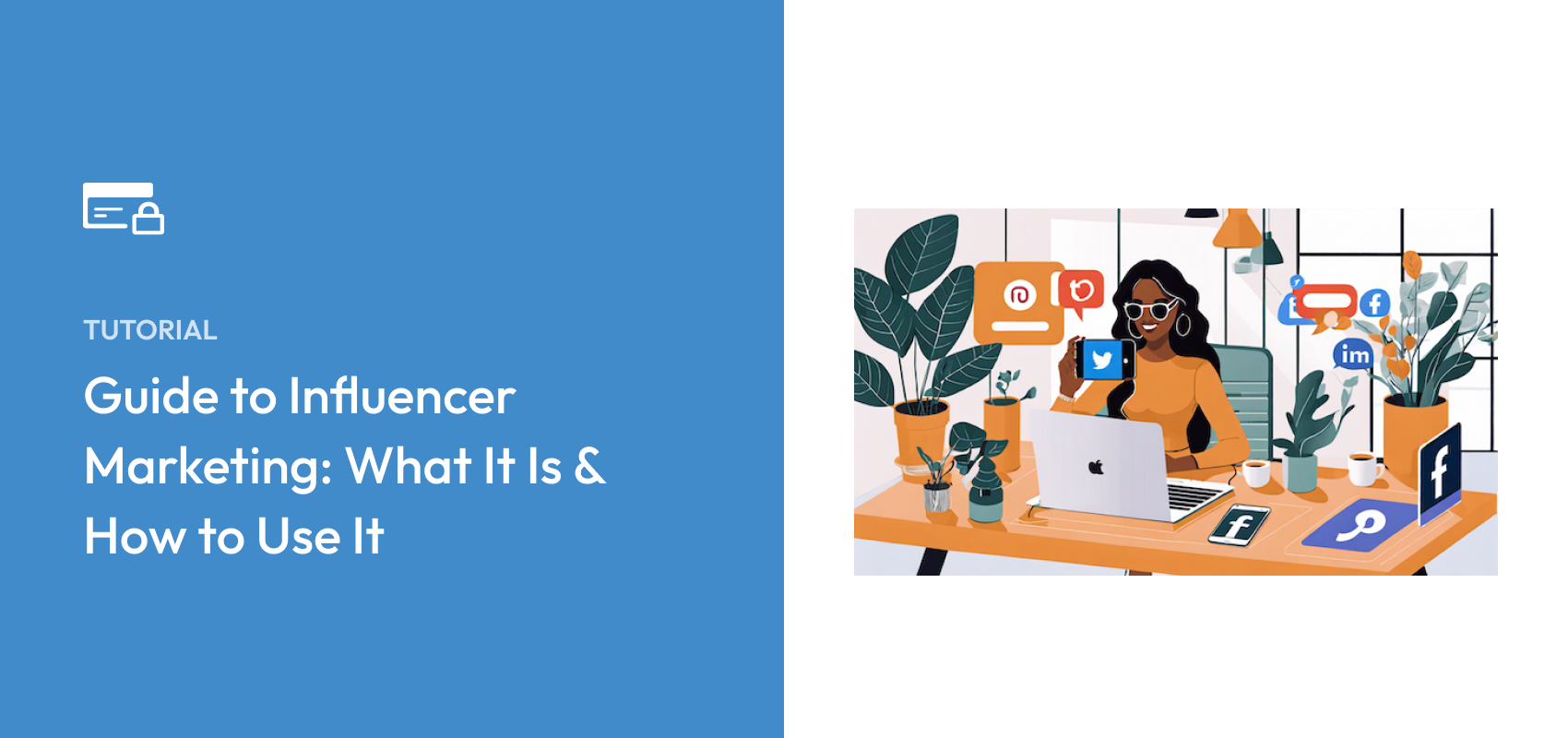Guide to Influencer Marketing: What It Is & How to Use it
Last updated on
Do you want to use influencer marketing to promote your products or services?
For small businesses, partnering with influencers is a powerful and cost-effective way to increase brand awareness, attract customers, and develop trust and authenticity.
In this article, we’ll explore influencer marketing and share a few ways you can leverage it to maximize your reach and grow your business.
In this Article
What is Influencer Marketing?
Influencer marketing is a form of social media marketing where businesses collaborate with individuals who have a significant online following and influence with a specific industry.
Influencer marketing has three key components:
- Influencers: People with established credibility and a loyal audience in a specific area. Influencers are typically made up of bloggers, YouTubers, and content creators.
- Partnerships: Brands work with influencers to promote their products or services. These partnerships often involve sponsored content, product placements, or affiliate links.
- Social Media Reach: Influencers leverage social media platforms, like Facebook, Instagram, YouTube, and TikTok, to share brand messages with engaged followers.
To succeed with influencer marketing, it’s essential to understand that it is not as simple as finding the most-followed profiles on social media platforms and paying them to promote your products or services.
Joining online marketing communities on social media platforms like Facebook and LinkedIn is a great way to network with like-minded people, make new connections, and perhaps identify an influencer partner that fits your needs.
Let’s explore a few best practices for maximizing the potential of influencer marketing.
1. Go Beyond the Influencer’s Follower Count
Follower count is the social media metric that gets the most attention, especially among brands that are considering paying people to increase the exposure of their product or service.
However, judging the potential value of influencer partnerships based on follower count alone is a misguided approach to this kind of marketing.
Now that everyone knows companies will pay serious money to social media users with many followers, buying followers has become a common practice. Many unscrupulous aspiring influencers will buy followers they didn’t earn to make themselves more attractive to prospective clients.
These purchased followers are not the ideal audience for an influencer marketing campaign. You’ll need to consider the type of followers a potential influencer partner may have and decide if it aligns with your audience’s needs.
For example, if you offer a cloud-based accounting software targeted at CFOs, targeting a startup entrepreneur with 500,000 followers might be effective.
On the other hand, an influencer explicitly focused on corporate accounting or CFOs with only 40,000 followers could be a more effective influencer partner for you because they likely have more potential customers in their audience even though their total reach is smaller.
This simple example represents why digging deeper than the numbers is so important. When it comes to influencer marketing, authenticity is key.
2. Ask for Audience Data
You don’t need to be a social media expert to understand follower counts, but as we mentioned above, followers don’t tell the entire story.
A few additional metrics to consider include:
- Engagement: This broad metric includes likes, shares, comments, and reposts. As the name implies, engagement is a way to determine how active a social media account’s followers are. A smaller audience with higher engagement can be much more valuable than an account with a larger audience that doesn’t pay close attention to their posts.
- Follower Growth: How often does a social media account gain or lose followers? The growth or churn rate indicates the frequency at which people start or stop following the account. Ideally, you want a steady growth rate showing that the account gets increased attention over time.
- Impressions: This tells you the specific number of times an account’s post gets viewed by other users. Unlike engagement, when a viewer takes action on a post by sharing or liking it, impressions tell you when a post appears on someone’s feed or timeline.
The specific kinds of metrics you ask about will vary depending on the nature of your campaign and its goals. Asking for additional information from a potential influencer partner can give you a lot of information about him or her.
If they are hesitant to go into detail about their social media audience or talk to you about numbers besides their follower count, it’s a sign that they might not be a good partner.
3. Add Value Outside of Your Promotion
Once you’ve researched and identified a good influencer partner, the next step is to plan your campaign. While your natural instinct will be to focus on your own product or service, it’s essential to go beyond simple promotion and provide something worth consuming for the new audience.
After years of popups and spammy emails, most social media users are weary of overly promotional digital marketing campaigns. If all you talk about is your own business or product without relating it to the user, people will scroll past the posts or messages in your campaign.
Instead, once you’ve decided on an influencer to partner with, spend some time researching their audience.
Think about the average person in that audience: What are they worried about? What’s preventing them from achieving the kind of success they want, personally or professionally? What kind of goals are they looking to meet?
It may even be smart to create a buyer persona (an in-depth profile of your ideal customer).
The influencer you’re working with should be able to provide plenty of guidance on what works and what doesn’t work for their audience. After all, they have a vested interest in the success of your campaign, as it can give them future business, too!
4. Create Evergreen Content From Your Campaign
Many marketing campaigns are associated with one-off events like conferences, awards ceremonies, or product releases. Then, after the event has ended, the value of the campaign’s assets dwindles significantly.
Influencer marketing can be similar, but it doesn’t have to be. This is where evergreen marketing comes in. This process involves repurposing and transforming your content from the original campaign to create additional relevant content.
For example, let’s say you’ve engaged a well-known influencer in your field for a social media takeover, a common type of campaign that most experienced social media users have seen. Of course, you’ll want to promote the specific takeover day to get people paying attention to the campaign.
However, you can still use it in your marketing efforts even after the takeover event.
Let’s say part of the takeover was a Q&A with your influencer’s audience. You might edit that segment into smaller clips of your team answering specific questions about your product or service.
You can post those clips anytime, even long after the takeover event. This maximizes your sources of content and helps you create more marketing content in the future.
Ultimately, the more content you can get from each campaign, the less you’ll need to spend on marketing.
5. Use Influencer Marketing to do Something Different
Many companies, especially those that have been doing digital marketing for a long time, are familiar with the feeling of being stuck in a rut. In these situations, it can feel like you’re making the same posts all the time, leading to a limited audience and stagnating your digital marketing efforts.
A successful influencer marketing campaign is an opportunity to break out of the box.
The influencer you work with will have a slightly different audience than yours, with different goals and expectations than yours. Switching things up can get you a better response. You may even discover a new type of post or promotion that becomes part of your regular strategy going forward.
There you have it! We hope this article has helped you learn more about influencer marketing and how you can use it to expand your reach, enhance your authenticity, and ultimately grow your business.
If you liked this article, you might also want to check out our guide on how to create an affiliate marketing program in WordPress.
What are you waiting for? Get started with WP Simple Pay today!
To read more articles like this, follow us on X.
Disclosure: Our content is reader-supported. This means if you click on some of our links, then we may earn a commission. We only recommend products that we believe will add value to our readers.


